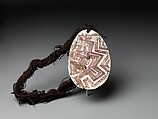Engraved pearl shell and hair-string belt (riji, or jakoli, longkalongka)
Not on view
Pearl shell was the highly prized focus of ritual and exchange networks in Australia. Its glistening iridescent qualities embody the shimmer of water, rain, and lightning, evoking ideas of spiritual well-being and ancestral connection. Engraved pearl shell pendants were given to boys during rites that marked their transition to adulthood and were predominantly used and worn by men during ceremonies, attached by belts or necklaces of hair string, with the power to bring rain or heal the sick. Known by a variety of local names (including riji, jakuli, longkalongka) they were, and in many areas still are, exchanged along a vast network of overland trade routes that extends along the western coast and across the vast desert interior as far as Australia’s southern shore, more than a thousand miles away. Carved from the shell of the gold-lipped pearl oyster (Pinctada maxima), each is engraved with a series of angular geometric motifs which are filled with red ocher and fat, or powdered charcoal to highlight dynamic designs. These linear elements meander across the surface of the lustrous inner lip of the shell and are typically composed of three parallel lines which flow and interlock to create animated designs. The geometry of these interlocking zig-zags and meandering lines indicate the movement of water, so vital to life, in its many manifestations: the rain of storm clouds, the ebb and flow of tides, and the tracks of ancestral beings such as the Lightning Snake across the landscape.
Due to rights restrictions, this image cannot be enlarged, viewed at full screen, or downloaded.
This artwork is meant to be viewed from right to left. Scroll left to view more.




